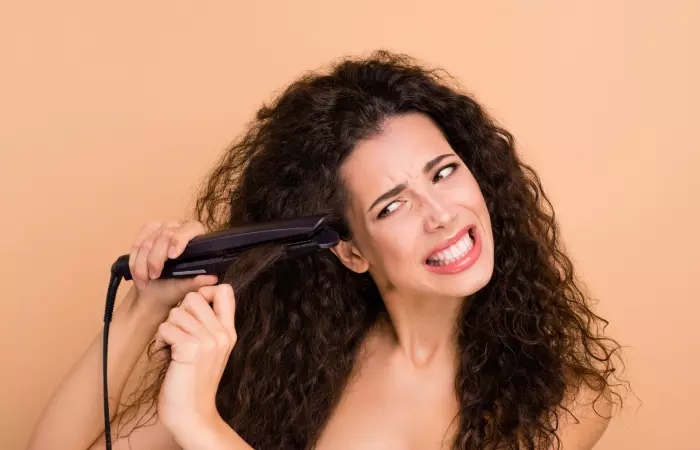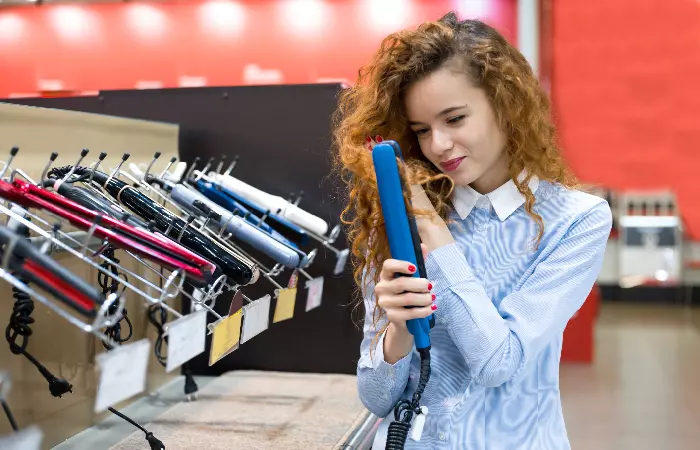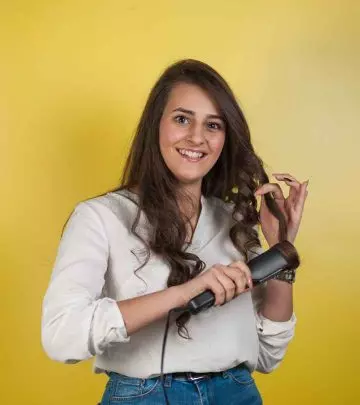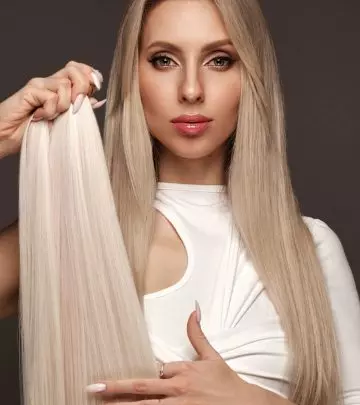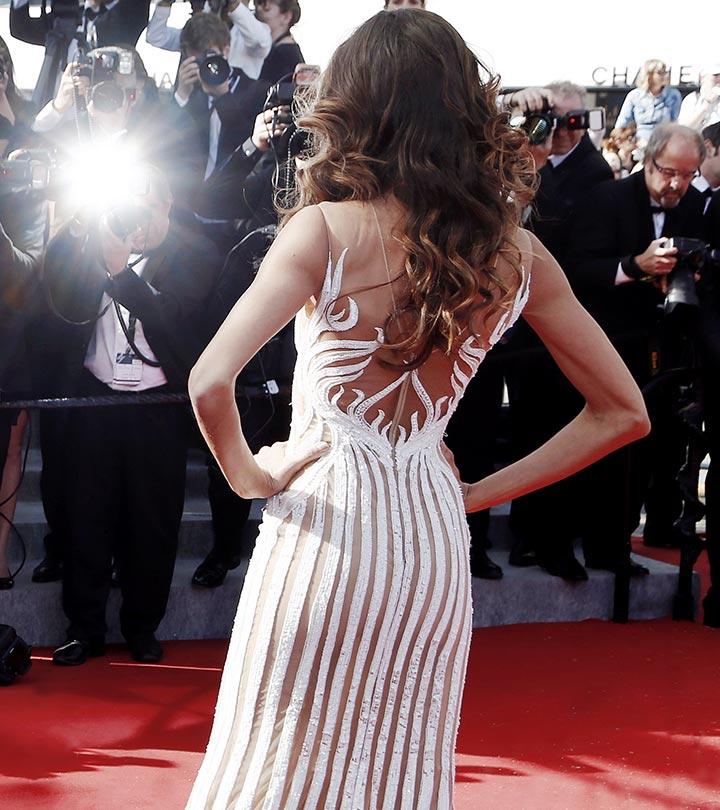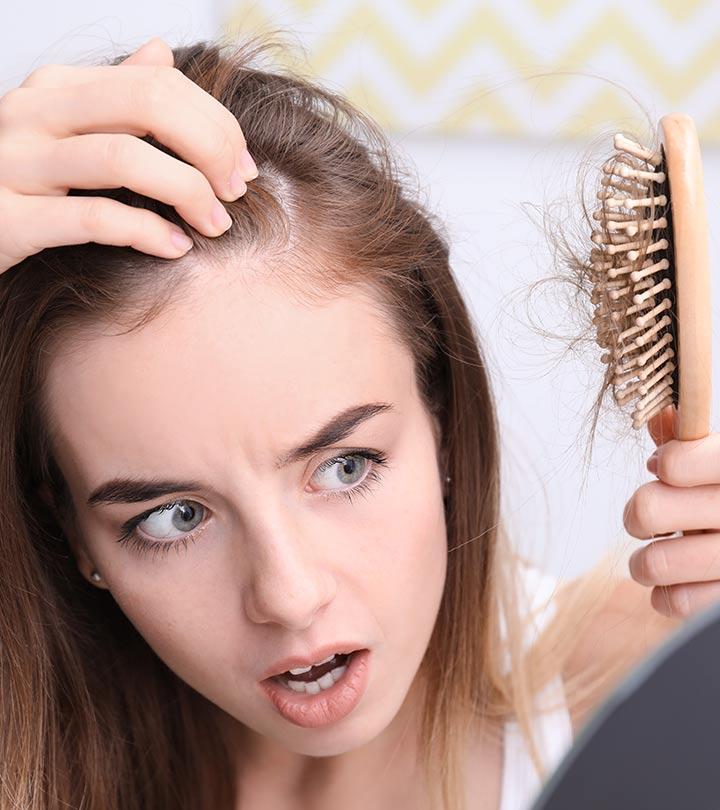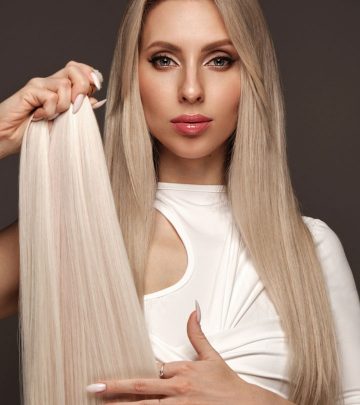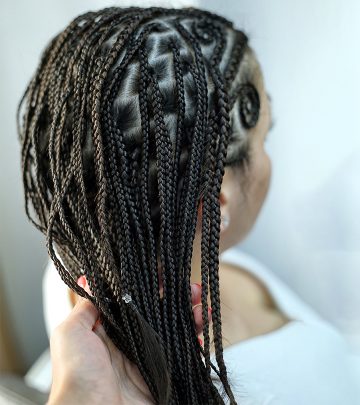Ceramic Vs. Titanium Hair Straightener: Which Is Better?
Find your perfect flat iron and say goodbye to damage and hello to shiny, healthy hair.
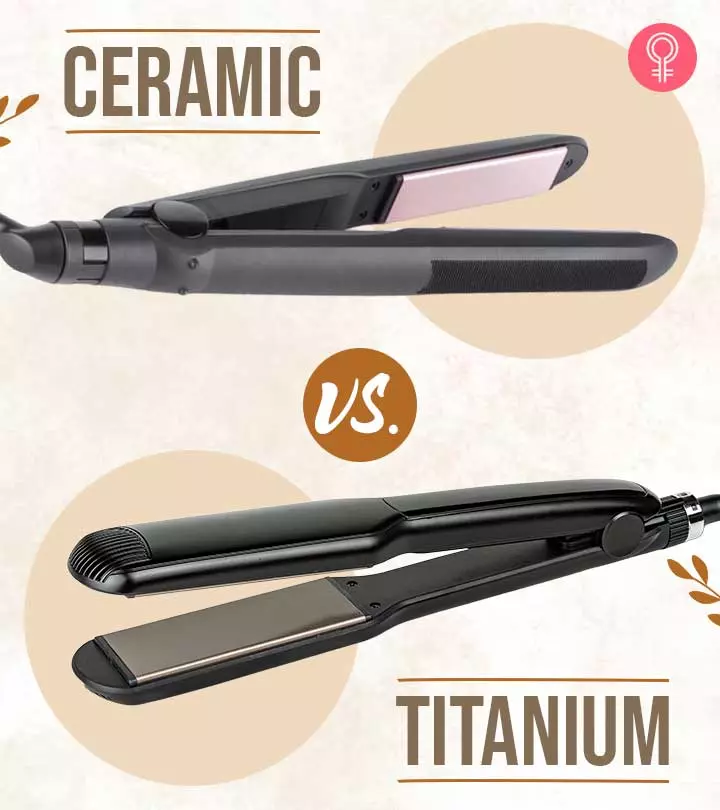
Image: StyleCraze Design Team
A quality hair straightening iron is a must-have styling tool in every girl’s beauty arsenal. Unlike permanent chemical straightening treatments, a flat iron provides temporary results so you can switch between straight, wavy, and curly hairstyles without committing to an irreversible change. However, the debate between ceramic vs. titanium hair straighteners seems never-ending. Both these materials boast distinct features and benefits, leaving consumers pondering which option reigns supreme. If you are one among them, understanding the differences between ceramic and titanium straighteners is essential for selecting the perfect match for your hair. This article delves into all the important things you must consider to make an informed decision, from basic factors like the heat conduction of these materials to their technology, performance, and durability. Dive in now!
In This Article
What Is The Difference Between Ceramic Vs. Titanium Hair Straighteners?
Ceramic and titanium hair straighteners are both popular choices for achieving sleek, straight hair. However, their heating plates are made of different materials. One has a plate made of ceramic, a non-metal inorganic material, while the other has a lightweight, titanium metal plate. These materials vary from each other greatly in terms of heat conduction, durability, hair type, styling needs, and a lot more. Listed below are some main comparisons of a few ceramic vs. titanium hair straightener aspects to help you make an informed decision.
1. Heat Conduction
When it comes to hair straighteners, heat conduction refers to the transfer of heat from the heating plate of the straightener to the hair strands. Now, the rate at which this heat transfers is different for both ceramic and titanium plates.
- Ceramic hair straighteners take time to heat and allow even heat distribution across the plates. This prevents hot spots and ensures that each strand of hair receives consistent heat, resulting in uniform straightening and a reduced risk of heat damage. This also makes these straighteners ideal for beginners.
- Titanium straighteners heat up quickly and generate slightly more heat than ceramic flat irons. They also stay hot for a longer time. While this may be advantageous for certain hair types, such as thick and coarse hair, you need to practice careful temperature control to prevent hair damage.
 Trivia
TriviaNote: It is important to note that ceramic plates differ from ceramic-coated plates. The former refers to plates that are entirely made of ceramic material, whereas the latter only have a layer of ceramic applied over a different base material, typically a metal.
2. Heat Transfer
Flat irons use different heat transfer methods to effectively straighten your locks while minimizing damage.
- Ceramic hair straighteners transmit heat through infrared technology. This technology heats the hair from the inside out, rather than just heating the surface. The process is gentler and may minimize long-term heat damage. It also helps seal moisture in the strands, resulting in smoother and shinier hair.
- Titanium irons distribute heat primarily through surface transfer. Since titanium is an excellent heat conductor, the healing plates heat up quickly when electricity flows through them. When they come into direct contact with the hair shafts, they heat only their surface. This kind of faster heat transfer is ideal for fast styling sessions. However, it increases the risk of overheating if not handled with care, leading to hair damage.
3. Performance
The effectiveness and performance of ceramic and titanium hair straighteners depends on your hair type and preferred style needs.
- Ceramic plate straighteners are versatile and are generally gentle on the hair, making them a popular choice for regular use. However, since they do not heat up as quickly as titanium flat irons, they may require more applications to straighten the hair. This means that these straighteners generally need more styling time.
- Titanium straighteners are ideal for quick styling, as they heat up in no time. Additionally, they retain the heat throughout the styling process and straighten the hair quickly, requiring fewer applications. However, you need to use them with care to avoid hair damage due to their potential for increased heat exposure.
4. Hair Type
While the right straightener can produce smoother, sleeker results for your specific hair type, the wrong one may result in ineffective straightening or worse, damage.
- Ceramic straighteners provide more gentle heat, making them suitable for most hair types, ranging from fine and normal to damaged, dry, and fragile hair.
- Titanium straighteners can reach higher temperatures and maintain consistent heat, making them better suited for thick or coarse hair types that are hard to straighten.
5. Durability
The durability of your hair straightener may vary depending on several factors such as the plate material of your hair straightener.
- Ceramic plates are durable and resistant to scratching or chipping, making them less likely to sustain damage from frequent use. However, they may be more prone to cracking or breaking if dropped or mishandled.
- Titanium plates are also durable and resistant to scratching and may withstand the daily wear and tear of regular use. They are also lightweight and corrosion-resistant, contributing to their long-term durability. This type of hair straightener is often preferred by professional stylists in hair salons due to its robust construction and ability to withstand heavy styling demands.
6. Smoothening And Frizz Control
Smoothening and frizz control are important factors for choosing hair straighteners, as they directly impact the quality and appearance of the hair after styling. The good news is that there is not much difference between ceramic and titanium straighteners when it comes to these factors.
- Ceramic flat iron plates generate negative ions when heated, which help neutralize positive ions found in frizzy, dry hair. They also glide smoothly over the hair, sealing the hair cuticles, reducing friction, and minimizing damage.
- While titanium plates do not come with negative ion technology, they still have an ultra-smooth surface that also helps seal hair cuticles. This may work well on frizzy hair and provide a smooth finish. However, if your straightener temperature is too high, these plates may actually add to the frizz by drying out the hair.
7. Price
Choosing a hair straightener based solely on price is not necessarily the most important factor. However, it still does matter if you need a styling tool within your budget.
- When it comes to ceramic and titanium straighteners, the former may be slightly more costly. That said, you can still find affordable options for ceramic flat irons on the market.
- It is also a good idea to see if your preferred titanium or ceramic flat irons provide warranty coverage and customer support. This will provide you with peace of mind and assistance if you encounter any issues with your device.
Note: As mentioned earlier, ceramic plates and ceramic-coated plate flat irons are different. Ceramic-coated plate options are generally cheaper than ceramic plate straighteners. However, their coating can wear off over time, exposing the underlying material that may affect the performance and lifespan of the styling tool.
 Trivia
TriviaBoth ceramic and titanium hair straighteners come with their unique set of benefits and considerations. So, which of the two is better for your personal needs? Find out below!
Is A Ceramic Or Titanium Flat Iron Better?
There is no direct answer to the question ‘what is better; a ceramic or a flat iron?’. The decision of choosing one between them often comes down to a few factors such as personal preference, hair type, and styling needs.
- You can opt for a ceramic flat iron if you have fine, normal, dull, damaged, and dry straight or wavy hair.
- Go for a titanium hair straightener for thick, coarse, and naturally curly or wavy hair.
- Ceramic hair straighteners are a good option for everyday styling. .
- Pick a titanium hair straightener for professional use or quick styling sessions.
- If you are looking for a straightener for frizzy hair that offers a smooth finish, both options are effective.
- If you are concerned about your long-term hair health, opt for ceramic plates, as they are gentler on the hair and may help minimize damage.
An important thing to note here is that both of these flat irons cause some hair damage. Ceramic-plated irons cause less damage than titanium straighteners since they heat up slowly and do not reach high temperatures quickly. However, exposing your hair to excessive heat with these styling tools is linked to acquired trichorrhexis nodosa, a disorder of the hair shaft characterized by thickened or weak points that lead to breakage (1). Therefore, it is also important to prioritize hair health and use both these types of hair straighteners with caution. Here are some tips for the same:
- Always use a heat protectant before styling your locks. They form a protective barrier between your hair and the heat of the flat iron, minimizing damage and preventing excessive dryness or breakage.
- Both ceramic and titanium hair straighteners have adjustable temperature settings. Use a lower heat setting if your hair is fine or damaged, and reserve higher temperatures for thick or coarse hair types. Avoid using the highest heat setting unnecessarily or for too long.
- Always ensure your hair is completely dry before straightening, as using a straightener on wet hair may cause more damage.
- Straighten your hair in sections to avoid going over the same areas repeatedly.
- Opt for regular deep conditioning treatments to help maintain the overall health and integrity of your hair.
Additionally, you should give your hair breaks between straightening sessions to recover and rejuvenate. This will not only keep your stands healthy but also help you embrace your naturally curly or wavy hair. Simona Elena, a primary school teacher and blogger, shares that she started straightening her naturally curly hair during puberty. However, regularly straightening her locks regularly caused damage. She writes, “I had to learn though that using a straightener all the time is not good for my hair. I stopped it and learned to appreciate my natural hair (i).”
The choice between ceramic vs. titanium hair straighteners ultimately depends on your hair type, styling preferences, time, material durability, and budget considerations. The plates used in both these options have their distinct advantages and limitations. While ceramic flat irons are gentle on the strands, they take up time to heat. These plates are ideal for beginners and daily use. Titanium straighteners, on the other hand, heat up quickly and provide rapid heat transfer for quick styling. They are great for professional hair styling and stubborn hair textures but may be harsh on fine and damaged hair. Also, it is essential to prioritize proper hair care practices, such as using a heat protection spray before using heat styling tools, avoiding excessive heat exposure, and following a regular hair care routine. This will ensure you have strong, shiny, and healthy hair.
Frequently Asked Questions
Can a ceramic straightener create curls and waves in addition to straightening hair?
Yes, ceramic straighteners can be used to create curls and waves in addition to straightening hair. You can do this by twisting a small section of hair around the straightener about an inch or two away from the roots. Then, clamp down the tool and gently pull it down the length of your hair as if you were straightening your hair.
Which type of straightener, ceramic or titanium, is less likely to pull or snag hair during styling?
Both ceramic and titanium straighteners do not generally pull or snag your hair while styling. However, since ceramic straighteners are gentler than titanium irons, their chance of snagging and pulling is less compared to the latter.
Which type of hair straightener is easier to clean and maintain: ceramic or titanium?
Both ceramic and titanium straighteners are easy to clean and maintain when handled with care. You can ensure that their plates stay free of residue from hair products and natural oils from your strands by regularly wiping them with a damp cloth or a mild cleaning solution.
Key Takeaways
- Ceramic straighteners heat up slowly and are gentle on the hair, while titanium straighteners heat up quickly and offer high heat levels.
- Ceramic irons are suitable for everyday styling, while titanium straighteners are preferred for quick styling sessions.
- Ceramic straighteners are suitable for most hair types, including fine and damaged hair, while titanium straighteners are better for thicker or coarser, textured hair.
- Ceramic irons may crack or break if dropped or mishandled, while titanium straighteners are lightweight and corrosion-resistant.
Choosing the right hair straightener is important to ensure your strands stay smooth and damage-free. This video contains information that will help you decode the ceramic vs. titanium flat iron differences. Check it out!
Personal Experience: Source
StyleCraze's articles are interwoven with authentic personal narratives that provide depth and resonance to our content. Below are the sources of the personal accounts referenced in this article.
(i) My hair story
https://simonascornerofdreams.blogspot.com/2016/07/my-hair-story.html
References
Articles on StyleCraze are backed by verified information from peer-reviewed and academic research papers, reputed organizations, research institutions, and medical associations to ensure accuracy and relevance. Read our editorial policy to learn more.
- Acquired trichorrhexis nodosa secondary to trichoteiromania: prompt diagnosis using trichoscopy
https://www.ncbi.nlm.nih.gov/pmc/articles/PMC8923140/
Read full bio of Anjali Sayee
Read full bio of Vaishali Sinha






